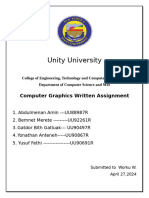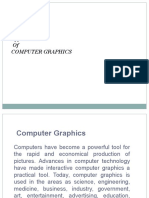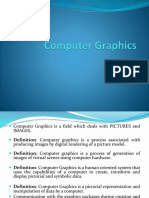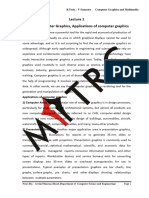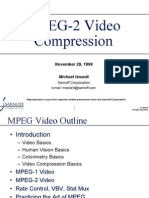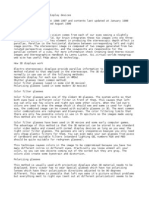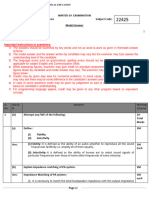Introduction To Graphics Application Unit-2
Uploaded by
richmakercasioIntroduction To Graphics Application Unit-2
Uploaded by
richmakercasioComputer Graphics
CAD
CAD stands for Computer-Aided Design. It refers to the use of computer software
and systems to create, modify, analyze, or optimize designs for various industries
such as architecture, engineering, and manufacturing. CAD software allows
designers and engineers to create 2D or 3D models of objects or systems, which
can be further used for visualization, simulation, and production.
CAD software provides tools and features that enable precise measurements,
geometric modeling, drafting, rendering, and documentation of designs. It offers a
wide range of functionalities, including the ability to manipulate objects, apply
materials and textures, simulate physical properties, and perform analysis such as
stress testing, fluid flow simulation, and motion analysis.
CAD has significantly revolutionized the design process, replacing traditional
manual drafting methods with digital tools. It enhances productivity, accuracy, and
collaboration among design teams, allowing them to iterate and refine designs
more efficiently. CAD models can be easily shared, modified, and stored
electronically, reducing the need for physical prototypes and streamlining the
overall design workflow.
CAD software is utilized in various industries, including architecture, automotive,
aerospace, industrial design, electrical and electronics, civil engineering, and
product manufacturing. It has become an integral part of the design and
development process, facilitating faster and more precise creation of complex
designs.
Presentation graphics
Presentation graphics refer to visual aids or materials used to enhance a
presentation and communicate information effectively to an audience. These
graphics typically include slides, charts, diagrams, images, and multimedia
elements that are displayed on a screen or projected onto a larger surface during a
presentation.
Abhishek A,Dept of CS,PESIAMS Shivamogga Page 1
Computer Graphics
Some common elements of presentation graphics include:
1. Slides: Presentation graphics are typically organized into individual slides, each
containing a specific topic or idea. Slides act as a canvas for displaying text,
images, and other graphical elements.
2. Text: Presenters use text to convey key points, provide explanations, or display
data. Fonts, colors, and formatting options can be used to enhance readability and
visual appeal.
3. Images and Graphics: Visual elements such as photographs, illustrations,
icons, and logos can be included to support and illustrate concepts. They help to
engage the audience and make the presentation more visually interesting.
4. Charts and Graphs: Data visualization tools are often used to present
numerical information in the form of charts, graphs, or infographics. These visual
representations make complex data easier to understand and interpret.
5. Animations and Transitions: Presentation graphics software allows users to
add animations and slide transitions to create visual effects and control the flow of
information during the presentation.
6. Multimedia Elements: Audio and video files can be embedded into
presentation slides to provide additional information, demonstrate a process, or add
interest to the presentation.
Effective presentation graphics help to convey information in a clear and concise
manner, grab the audience's attention, and enhance understanding and retention of
the presented content. They should be carefully designed to support the presenter's
message and facilitate effective communication.
Abhishek A,Dept of CS,PESIAMS Shivamogga Page 2
Computer Graphics
Application of Computer Graphics
1. Education and Training: Computer-generated model of the physical, financial
and economic system is often used as educational aids. Model of physical systems,
physiological system, population trends or equipment can help trainees to
understand the operation of the system.
For some training applications, particular systems are designed. For example Flight
Simulator.
Flight Simulator: It helps in giving training to the pilots of airplanes. These pilots
spend much of their training not in a real aircraft but on the ground at the controls
of a Flight Simulator.
Advantages:
1. Fuel Saving
2. Safety
3. Ability to familiarize the training with a large number of the world's airports.
2. Use in Biology: Molecular biologist can display a picture of molecules and gain
insight into their structure with the help of computer graphics.
3. Computer-Generated Maps: Town planners and transportation engineers can
use computer-generated maps which display data useful to them in their planning
work.
4. Architect: Architect can explore an alternative solution to design problems at an
interactive graphics terminal. In this way, they can test many more solutions that
would not be possible without the computer.
5. Presentation Graphics: Example of presentation Graphics are bar charts, line
graphs, pie charts and other displays showing relationships between multiple
parameters. Presentation Graphics is commonly used to summarize
o Financial Reports
o Statistical Reports
o Mathematical Reports
Abhishek A,Dept of CS,PESIAMS Shivamogga Page 3
Computer Graphics
o Scientific Reports
o Economic Data for research reports
o Managerial Reports
o Consumer Information Bulletins
o And other types of reports
6. Computer Art: Computer Graphics are also used in the field of commercial
arts. It is used to generate television and advertising commercial.
7. Entertainment: Computer Graphics are now commonly used in making motion
pictures, music videos and television shows.
8. Visualization: It is used for visualization of scientists, engineers, medical
personnel, business analysts for the study of a large amount of information.
9. Educational Software: Computer Graphics is used in the development of
educational software for making computer-aided instruction.
10. Printing Technology: Computer Graphics is used for printing technology and
textile design.
Image processing
In computer graphics, image processing refers to the manipulation and
modification of images to create or enhance graphical content. It involves various
techniques and algorithms that are specifically designed for computer-generated
images rather than real-world photographs or digital images.
Here are some common image processing techniques used in computer graphics:
Texture Mapping: Texture mapping is a process of applying a 2D image,
called a texture, onto a 3D model or surface. It enhances the visual realism of
computer-generated objects by giving them the appearance of texture, color,
and detail.
Filtering and Anti-aliasing: Filtering techniques are used to smooth out
jagged edges and reduce aliasing artifacts in computer-generated images.
Techniques such as bilinear filtering, trilinear filtering, and anisotropic
filtering help improve the quality and clarity of textures and rendered scenes.
Abhishek A,Dept of CS,PESIAMS Shivamogga Page 4
Computer Graphics
Image Warping: Image warping involves distorting or transforming an
image to achieve specific visual effects. It can be used to simulate
perspective transformations, create special effects, or correct for lens
distortion.
Image Compositing: Image compositing is the process of combining
multiple images or layers together to create a final composite image. This
technique is widely used in visual effects, animation, and digital matte
painting to integrate computer-generated elements seamlessly with real-world
footage or other computer-generated images.
Image Synthesis: Image synthesis techniques generate new images based on
mathematical models and algorithms. This includes rendering techniques
such as ray tracing, radiosity, and global illumination, which simulate the
behavior of light in a virtual scene to create realistic lighting and shading
effects.
Image-based Lighting: Image-based lighting (IBL) involves capturing and
using real-world lighting information to illuminate computer-generated
scenes. This technique enhances the realism of computer graphics by
incorporating real-world lighting conditions and reflections into the rendered
images.
Image Sampling and Reconstruction: Sampling and reconstruction
techniques play a crucial role in computer graphics to convert continuous
signals (such as light and color) into discrete digital representations.
Techniques such as anti-aliasing, adaptive sampling, and reconstruction
filters are used to accurately capture and represent visual information.
These image processing techniques in computer graphics contribute to creating
visually appealing and realistic computer-generated images and animations. They
are employed in various applications, including video games, movies, virtual
reality, computer-aided design (CAD), and architectural visualization.
Abhishek A,Dept of CS,PESIAMS Shivamogga Page 5
Computer Graphics
Display devices
Raster-Scan Displays
Raster Scan Displays are most common type of graphics monitor which employs
CRT. It is based on television technology. In raster scan system electron beam
sweeps across the screen, from top to bottom covering one row at a time.A
pattern of illuminated pattern of spots is created by turning beam intensity on and
off as it moves across each row. A memory area called refresh buffer or frame
buffer stores picture definition. This memory area holds intensity values for all
screen points. Stored intensity values are restored from frame buffer and painted
on screen taking one row at a time.Each screen point is referred to as pixels.
Raster-Scan Display Processor:
An important function of display process is to digitize a picture definition given
in an application program into a set of pixel-intensity values for storage in refresh
buffer. This process is referred to as scan conversion. The purpose of display
processors is to relieve the CPU from graphics jobs.
Display processors can perform various other tasks like: creating different line
styles, displaying color areas, etc. Typically display processors are utilized to
interface input devices, such as mouse, joysticks.
Abhishek A,Dept of CS,PESIAMS Shivamogga Page 6
Computer Graphics
ADVANTAGES:
Real life images with different shades can be displayed.
Color range available is bigger than random scan display.
DISADVANTAGES:
Resolution is lower than random scan display.
More memory is required.
Data about the intensities of all pixel has to be stored.
Color CRT Monitors:
The CRT Monitor display by using a combination of phosphors. The phosphors are
different colors. There are two popular approaches for producing color displays
with a CRT are:
1. Beam Penetration Method
2. Shadow-Mask Method
1. Beam Penetration Method:
The Beam-Penetration method has been used with random-scan monitors. In this
method, the CRT screen is coated with two layers of phosphor, red and green and
the displayed color depends on how far the electron beam penetrates the phosphor
layers. This method produces four colors only, red, green, orange and yellow. A
beam of slow electrons excites the outer red layer only; hence screen shows red
Abhishek A,Dept of CS,PESIAMS Shivamogga Page 7
Computer Graphics
color only. A beam of high-speed electrons excites the inner green layer. Thus
screen shows a green color.
Advantages:
1. Inexpensive
Disadvantages:
1. Only four colors are possible
2. Quality of pictures is not as good as with another method.
2. Shadow-Mask Method:
o Shadow Mask Method is commonly used in Raster-Scan System because
they produce a much wider range of colors than the beam-penetration
method.
o It is used in the majority of color TV sets and monitors.
Construction: A shadow mask CRT has 3 phosphor color dots at each pixel
position.
o One phosphor dot emits: red light
o Another emits: green light
o Third emits: blue light
Abhishek A,Dept of CS,PESIAMS Shivamogga Page 8
Computer Graphics
This type of CRT has 3 electron guns, one for each color dot and a shadow mask
grid just behind the phosphor coated screen.
Shadow mask grid is pierced with small round holes in a triangular pattern.
Figure shows the delta-delta shadow mask method commonly used in color CRT
system.
Abhishek A,Dept of CS,PESIAMS Shivamogga Page 9
Computer Graphics
Working: Triad arrangement of red, green, and blue guns.
The deflection system of the CRT operates on all 3 electron beams simultaneously;
the 3 electron beams are deflected and focused as a group onto the shadow mask,
which contains a sequence of holes aligned with the phosphor- dot patterns.
When the three beams pass through a hole in the shadow mask, they activate a
dotted triangle, which occurs as a small color spot on the screen.
The phosphor dots in the triangles are organized so that each electron beam can
activate only its corresponding color dot when it passes through the shadow mask.
Inline arrangement: Another configuration for the 3 electron guns is an Inline
arrangement in which the 3
Electron guns and the corresponding red-green-blue color dots on the screen, are
aligned along one scan line rather of in a triangular pattern.
Advantage:
1. Realistic image
2. Million different colors to be generated
3. Shadow scenes are possible
Disadvantage:
1. Relatively expensive compared with the monochrome CRT.
2. Relatively poor resolution
3. Convergence Problem
Direct View Storage Tubes:
DVST terminals also use the random scan approach to generate the image on the
CRT screen. The term "storage tube" refers to the ability of the screen to retain the
image which has been projected against it, thus avoiding the need to rewrite the
image constantly.
Abhishek A,Dept of CS,PESIAMS Shivamogga Page 10
Computer Graphics
Function of guns: Two guns are used in DVST
1. Primary guns: It is used to store the picture pattern.
2. Flood gun or Secondary gun: It is used to maintain picture display.
Advantage:
1. No refreshing is needed.
2. High Resolution
3. Cost is very less
Disadvantage:
1. It is not possible to erase the selected part of a picture.
2. It is not suitable for dynamic graphics applications.
3. If a part of picture is to modify, then time is consumed.
Abhishek A,Dept of CS,PESIAMS Shivamogga Page 11
Computer Graphics
LCD
LCD stands for Liquid Crystal Display. It is a flat panel display technology,
mainly used in TVs and computer monitors, nowadays it is used for mobile
phones also. These LCDs are completely different from that old CRT displays, it
uses liquid crystals instead of cathode ray in its primary form of operation.
In LCD display, it consists of millions of pixels made of crystal and arranged in a
rectangular grid. In LCD it has backlights that provide light to each pixel. Each
pixel has a red, green, and blue (RGB) sub-pixel that can be turned on or off.
When all of the sub-pixels are turned off, then it’s black and when all the sub-
pixels are turned on 100%, then it’s white.
LCD is a combination of two states of matter, the solid and the liquid. The solid
part is crystal and this liquid and crystal together make the visible image. LCD
consists of two layers which are two polarized panels- filters and electrodes. LCD
screen works by blocking the light rather than emitting the light. There are two
types of pixel grids in LCD:
Active Matrix Grid– It is a newer technology. In smartphone with LCD
display uses this technology.
Passive Matrix Grid– It is an older technology. Some older devices used this
technology.
Abhishek A,Dept of CS,PESIAMS Shivamogga Page 12
Computer Graphics
Also LCD has other characteristics in terms of many areas, that are
Resolution: LCD is made up of liquid crystal, which is neither liquid nor
solid, and this thing reflects the light in a well-formed way, lights enter into
the crystal and reflect very clearly. So the image made with this liquid crystal
is very accurate. LCD is a Digital display, which addresses each individual
pixel using a fixed matrix of horizontal and vertical dots. LCD scales the
image according to the resolution the device provided. So the quality of the
image is not degraded.
Brightness: Brightness means the light provided by the LCD, which is
nothing but the intensity of visible light, it is measured using nits. Nits is
defined as one candela per square meter. In LCD brightness is very much
accurate for the good resolutions and pixels.
Contrast Ratio: It is the ratio of the brightest color and the darkest color for a
particular position of the screen provided by the display. To calculate contrast
ratio(CR) see the below formula:
Typically the ratios of modern monitors are 1000:1 and TVs are 4000:1.
Response Rate: Response Rate is high in LCD, it means the time required for
changing colors of the pixels is very much less, so that the refresh rate is very
high in LCD than CRT. There is no lagging between the pixels when the
image is changed.
Advantages of LCD :
The main advantage of LCD is, it has low in cost and energy efficient and
very less power consumption.
LCD is thinner and lighter and very flexible.
LCD provides excellent contrast, brightness and resolution, so the picture
quality is very clear like a crystal.
Radiation of LCD monitors are much less than CRT monitors
LCDs can be suitable with CMOS integrated circuits so that making of LCD is
very easy.
It gives perfect sharpness at the native resolution
Zero geometric distortion at the native resolution of the pane
It provides various conveniences like portability as compared to previous
technology based screens.
Abhishek A,Dept of CS,PESIAMS Shivamogga Page 13
Computer Graphics
Disadvantages of LCD :
LCD require additional light sources for lighting the pixels, so if the light
source is destroyed then the LCD is not providing any image on the display.
LCD is less reliable display.
The image visibility depends on light intensity
The aspect ratio and resolution are fixed for LCD.
LCD has an irregular intensity scale and it produce lower than 256 discrete
intensity levels.
In LCD color saturation is reduced at the low intensity level due to poor black-
level.
LCD provide limited viewing angle, it effects the brightness. if we are
watching the screen by an angle then the color of the image is changed in our
eyes.
3D viewing devices
The three-dimensional transformations are extensions of two-dimensional
transformation. In 2D two coordinates are used, i.e., x and y whereas in 3D three
co-ordinates x, y, and z are used.
For three dimensional images and objects, three-dimensional transformations are
needed. These are translations, scaling, and rotation. These are also called as basic
transformations are represented using matrix. More complex transformations are
handled using matrix in 3D.
The 2D can show two-dimensional objects. Like the Bar chart, pie chart, graphs.
But some more natural objects can be represented using 3D. Using 3D, we can see
different shapes of the object in different sections.
In 3D when a translation is done we need three factors for rotation also, it is a
component of three rotations. Each can be performed along any three Cartesian
axis. In 3D also we can represent a sequence of transformations as a single matrix.
Abhishek A,Dept of CS,PESIAMS Shivamogga Page 14
Computer Graphics
3D Geometry
Three dimension system has three axis x, y, z. The orientation of a 3D coordinate
system is of two types. Right-handed system and left-handed system.
In the right -handed system thumb of right- hand points to positive z-direction and
left- hand system thumb point to negative two directions. Following figure show
right-hand orientation of the cube.
Using right-handed system co-ordinates of corners A, B, C, D of the cube
Point A x, y, z
Point B x, y, 0
Point C 0, y, 0
Point D 0, y, z
Producing realism in 3D: The three-dimensional objects are made using
computer graphics. The technique used for two Dimensional displays of three
Dimensional objects is called projection. Several types of projection are available,
i.e.,
Abhishek A,Dept of CS,PESIAMS Shivamogga Page 15
Computer Graphics
1. Parallel Projection
2. Perspective Projection
3. Orthographic Projection
1. Parallel Projection: In this projection point on the screen is identified within a
point in the three-dimensional object by a line perpendicular to the display screen.
The architect Drawing, i.e., plan, front view, side view, elevation are nothing but
lines of parallel projections.
2. Perspective Projection: This projection has a property that it provides idea
about depth. Farther the object from the viewer, smaller it will appear. All lines in
perspective projection converge at a center point called as the center of projection.
3. Orthographic Projection: It is simplest kind of projection. In this, we take a
top, bottom, side view of the object by extracting parallel lines from the object.
Abhishek A,Dept of CS,PESIAMS Shivamogga Page 16
Computer Graphics
Random Scan and Raster Scan Display:
Random Scan Display:
Random Scan System uses an electron beam which operates like a pencil to create
a line image on the CRT screen. The picture is constructed out of a sequence of
straight-line segments. Each line segment is drawn on the screen by directing the
beam to move from one point on the screen to the next, where its x & y coordinates
define each point. After drawing the picture. The system cycles back to the first
line and design all the lines of the image 30 to 60 time each second. The process is
shown in fig:
Random-scan monitors are also known as vector displays or stroke-writing
displays or calligraphic displays.
Advantages:
1. A CRT has the electron beam directed only to the parts of the screen where
an image is to be drawn.
2. Produce smooth line drawings.
3. High Resolution
Abhishek A,Dept of CS,PESIAMS Shivamogga Page 17
Computer Graphics
Disadvantages:
1. Random-Scan monitors cannot display realistic shades scenes.
Raster Scan Display:
A Raster Scan Display is based on intensity control of pixels in the form of a
rectangular box called Raster on the screen. Information of on and off pixels is
stored in refresh buffer or Frame buffer. Televisions in our house are based on
Raster Scan Method. The raster scan system can store information of each pixel
position, so it is suitable for realistic display of objects. Raster Scan provides a
refresh rate of 60 to 80 frames per second.
Frame Buffer is also known as Raster or bit map. In Frame Buffer the positions are
called picture elements or pixels. Beam refreshing is of two types. First is
horizontal retracing and second is vertical retracing. When the beam starts from the
top left corner and reaches the bottom right scale, it will again return to the top left
side called at vertical retrace. Then it will again more horizontally from top to
bottom call as horizontal retracing shown in fig:
Types of Scanning or travelling of beam in Raster Scan
1. Interlaced Scanning
2. Non-Interlaced Scanning
Abhishek A,Dept of CS,PESIAMS Shivamogga Page 18
Computer Graphics
In Interlaced scanning, each horizontal line of the screen is traced from top to
bottom. Due to which fading of display of object may occur. This problem can be
solved by Non-Interlaced scanning. In this first of all odd numbered lines are
traced or visited by an electron beam, then in the next circle, even number of lines
are located.
For non-interlaced display refresh rate of 30 frames per second used. But it gives
flickers. For interlaced display refresh rate of 60 frames per second is used.
Advantages:
1. Realistic image
2. Million Different colors to be generated
3. Shadow Scenes are possible.
Disadvantages:
1. Low Resolution
2. Expensive
Differentiate between Random and Raster Scan Display:
Random Scan Raster Scan
1. It has high Resolution 1. Its resolution is low.
2. It is more expensive 2. It is less expensive
3. Any modification if needed is easy 3.Modification is tough
4. Solid pattern is tough to fill 4.Solid pattern is easy to fill
5. Refresh rate depends or resolution 5. Refresh rate does not depend on the picture
Abhishek A,Dept of CS,PESIAMS Shivamogga Page 19
Computer Graphics
6. Only screen with view on an area is displayed. 6. Whole screen is scanned.
7. Beam Penetration technology come under it. 7. Shadow mark technology came under this.
8. It does not use interlacing method. 8. It uses interlacing
9. It is restricted to line drawing applications 9. It is suitable for realistic display.
Abhishek A,Dept of CS,PESIAMS Shivamogga Page 20
You might also like
- CMP461 Computer Graphics and Animations 2nd NoteNo ratings yetCMP461 Computer Graphics and Animations 2nd Note171 pages
- computer graphics unit 1 bca 4th sem ccsuNo ratings yetcomputer graphics unit 1 bca 4th sem ccsu45 pages
- CMP461 Computer Graphics and AnimationsNo ratings yetCMP461 Computer Graphics and Animations175 pages
- COMPUTER GRAPHICS AND MULTIMEDIA Unit 1No ratings yetCOMPUTER GRAPHICS AND MULTIMEDIA Unit 163 pages
- Comp Graphics Notes All Chaps Comp Graphics Notes All ChapsNo ratings yetComp Graphics Notes All Chaps Comp Graphics Notes All Chaps31 pages
- 3 Chapter 03 CS100 ARTS COmputer GraphicsNo ratings yet3 Chapter 03 CS100 ARTS COmputer Graphics49 pages
- Computer Graphics: Presented By: Yogesh Nagaraj NaikNo ratings yetComputer Graphics: Presented By: Yogesh Nagaraj Naik26 pages
- Introduction To Computer Graphics: Unit - INo ratings yetIntroduction To Computer Graphics: Unit - I379 pages
- COMPUTER GRAPHICS Summary Note nd1 .... - 1No ratings yetCOMPUTER GRAPHICS Summary Note nd1 .... - 117 pages
- USIT 405 Computer Graphics and Animation MunotesNo ratings yetUSIT 405 Computer Graphics and Animation Munotes218 pages
- SM_e088f60a-b2cb-4f95-b71c-8ca2a9747286_58No ratings yetSM_e088f60a-b2cb-4f95-b71c-8ca2a9747286_5829 pages
- Basic of Computer Graphics, Applications of Computer GraphicsNo ratings yetBasic of Computer Graphics, Applications of Computer Graphics10 pages
- Uses of Computer Graphics Computer Aided DesignNo ratings yetUses of Computer Graphics Computer Aided Design3 pages
- Rendering Computer Graphics: Exploring Visual Realism: Insights into Computer GraphicsFrom EverandRendering Computer Graphics: Exploring Visual Realism: Insights into Computer GraphicsNo ratings yet
- Geometric Modeling: Exploring Geometric Modeling in Computer VisionFrom EverandGeometric Modeling: Exploring Geometric Modeling in Computer VisionNo ratings yet
- Global Illumination: Advancing Vision: Insights into Global IlluminationFrom EverandGlobal Illumination: Advancing Vision: Insights into Global IlluminationNo ratings yet
- Ics 2303 Multimedia Systems and Applications100% (1)Ics 2303 Multimedia Systems and Applications55 pages
- Computer Graphics: Week 4: Presentation By: Ms. Ifrah MansoorNo ratings yetComputer Graphics: Week 4: Presentation By: Ms. Ifrah Mansoor48 pages
- Video Transmission Jerkiness Measure: Deena AbdelsamadNo ratings yetVideo Transmission Jerkiness Measure: Deena Abdelsamad38 pages
- Life's Good Life's Safe: LG Security SystemNo ratings yetLife's Good Life's Safe: LG Security System51 pages
- 2019 Winter Model Answer Paper (Msbte Study Resources)No ratings yet2019 Winter Model Answer Paper (Msbte Study Resources)30 pages
- Fundamentals of TV (Scanning, Synchronization, Video Signals Etc.)100% (1)Fundamentals of TV (Scanning, Synchronization, Video Signals Etc.)23 pages
- Understanding The Difference Between SD and HD: ResolutionNo ratings yetUnderstanding The Difference Between SD and HD: Resolution4 pages
- Comp Graphics Notes All Chaps Comp Graphics Notes All ChapsComp Graphics Notes All Chaps Comp Graphics Notes All Chaps
- Computer Graphics: Presented By: Yogesh Nagaraj NaikComputer Graphics: Presented By: Yogesh Nagaraj Naik
- Basic of Computer Graphics, Applications of Computer GraphicsBasic of Computer Graphics, Applications of Computer Graphics
- Rendering Computer Graphics: Exploring Visual Realism: Insights into Computer GraphicsFrom EverandRendering Computer Graphics: Exploring Visual Realism: Insights into Computer Graphics
- Geometric Modeling: Exploring Geometric Modeling in Computer VisionFrom EverandGeometric Modeling: Exploring Geometric Modeling in Computer Vision
- Global Illumination: Advancing Vision: Insights into Global IlluminationFrom EverandGlobal Illumination: Advancing Vision: Insights into Global Illumination
- Computer Graphics: Week 4: Presentation By: Ms. Ifrah MansoorComputer Graphics: Week 4: Presentation By: Ms. Ifrah Mansoor
- Video Transmission Jerkiness Measure: Deena AbdelsamadVideo Transmission Jerkiness Measure: Deena Abdelsamad
- 2019 Winter Model Answer Paper (Msbte Study Resources)2019 Winter Model Answer Paper (Msbte Study Resources)
- Fundamentals of TV (Scanning, Synchronization, Video Signals Etc.)Fundamentals of TV (Scanning, Synchronization, Video Signals Etc.)
- Understanding The Difference Between SD and HD: ResolutionUnderstanding The Difference Between SD and HD: Resolution




















